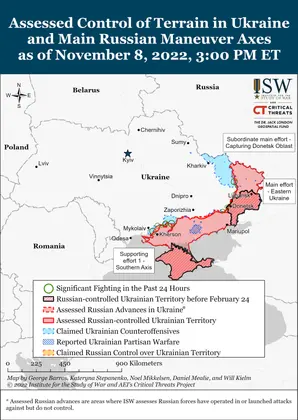Key Takeaways
- Iranian sources announced—without Russian confirmation—that Russian National Security Council Secretary Nikolai Patrushev arrived in Tehran on November 8, likely to discuss the potential sale of Iranian ballistic missiles to Russia. Iran likely announced Patrushev’s arrival to highlight the deepening cooperation between Moscow and Tehran to an international audience, as well as to implicitly highlight that a high-ranking Russian official turned to Iran for help in Ukraine.
- Wagner Group forces are continuing to exaggerate their claimed territorial gains in Donbas to further distinguish themselves from proxy and conventional Russian forces.
- Ukrainian forces likely made marginal gains northwest of Svatove, Luhansk Oblast, and Russian sources claimed that Ukrainian forces intensified offensive operations toward Kreminna.
- Russian forces continued offensive operations around Bakhmut, Avdiivka, and in western Donetsk Oblast.
- Ukrainian authorities attempted to counteract Russian authorities’ continued efforts to strengthen control of the Zaporizhzhia Nuclear Power Plant (ZNPP).
- The disproportionate financial burden of Russian force generation efforts continues to fall primarily on Russian regional governments’ budgets, prompting public backlash.
- Financial and bureaucratic issues are continuing to hinder Russian efforts to replenish formerly elite units defending critical areas of the front line, potentially threatening the integrity of Russian defenses in occupied parts of Ukraine.
- Russian occupation authorities in Kherson Oblast may be trying to force residents out of the western part of the oblast by cutting communications on the west bank of the Dnipro River.
Iranian state-run outlet Nour News Agency reported that Russian National Security Council Secretary Nikolai Patrushev arrived in Tehran on November 8, likely to discuss the potential sale of Iranian ballistic missiles to Russia. Nour News Agency announced Patrushev’s arrival in an English-language tweet, stating that Iranian Supreme National Security Council (SNSC) Secretary Ali Shamkhani invited Patrushev and noted that Patrushev will also meet with other high-ranking Iranian political and economic officials to discuss Russo-Iranian cooperation. Nour News Agency is affiliated with the SNSC. The SNSC likely announced Patrushev’s arrival in Iran to highlight the deepening cooperation between Moscow and Tehran to an international audience (rather than domestically), as well as to implicitly highlight that a high-ranking Russian official turned to Iran for help in Ukraine. Islamic Revolutionary Guards Corps (IRGC) Quds Force Commander Qassem Soleimani notably traveled to Moscow in 2015 to appeal to Russia to intervene in the Syrian Civil War. Tehran is likely eager to publicly signal this rebalancing of its strategic partnership with Moscow, especially to regional Iranian adversaries with which the Kremlin occasionally cooperates, such as Israel and Saudi Arabia. Patrushev’s visit to Iran notably comes amid reports that the Iranian regime is seeking Russian help with protest suppression, although it is unclear if this will be discussed by Patrushev and his Iranian counterpart.

N. Korean Troops Massed in Russia to Enter Ukraine War ’Soon’: Pentagon Chief
JOIN US ON TELEGRAM
Follow our coverage of the war on the @Kyivpost_official.
The Kremlin is continuing efforts to covertly acquire munitions for use in Ukraine to mitigate the effects of international sanctions and backfill Russia’s ongoing depletion of domestic munitions stockpiles. British outlet Sky News reported on November 8 that the Kremlin flew 140 million euros in cash and a selection of captured British-made NLAW anti-tank missiles, US-made Javelin anti-tank missiles, and a Stinger anti-aircraft missile to Tehran on August 20 in exchange for 160 additional Shahed-136 drones for use in Ukraine. The Ukrainian Resistance Center reported on November 8 that Tehran continues to supply Moscow with Mohajer, Arash, and Shahed-type drones by air and sea via both Iranian state-owned and privately-owned entities. The Ukrainian Resistance Center additionally reported that due to failures of the Russian military-industrial complex, Russian military leaders are continuing their efforts to procure dual-use (military and non-military use) goods such as computer chips, quadcopters, night vision devices, and bulletproof vests from Turkey and are using cryptocurrency transactions to avoid purchase tracking. Taken in tandem, these reports indicate that the Kremlin seeks to circumvent sanctions by engaging in quid-pro-quo and under-the-table negotiations with foreign actors.
Wagner Group forces are continuing to exaggerate their claimed territorial gains in Donbas to further distinguish themselves from proxy and conventional Russian forces. Russian sources began reporting on November 7 that a detachment of Wagner forces and troops of the Luhansk People’s Republic (LNR) 6th Cossack Regiment broke through Ukrainian defensive lines in Bilohorivka, Luhansk Oblast. On November 8, however, Russian coverage largely shifted and Russian milbloggers began claiming that reports of the 6th Cossack Regiment’s involvement in operations near Bilohorivka are false and that Wagner troops were solely responsible for purported gains. As ISW has previously observed, Wagner has taken sole credit for Russian gains around Bakhmut in order to bolster their own reputation as the Kremlin’s favored strike force, despite not being the only force deployed in the area. Wagner will likely use Bilohorivka to accomplish a similar effect.
You can also highlight the text and press Ctrl + Enter






